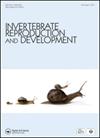Invertebrate oogenesis – a review and synthesis: comparative ovarian morphology, accessory cell function and the origins of yolk precursors
IF 0.8
4区 生物学
Q4 REPRODUCTIVE BIOLOGY
引用次数: 15
Abstract
ABSTRACT Oogenesis is a fundamental biological process observed in most animals. Animals employ many different mechanisms to make their eggs and oogenesis cannot be completed without the support of other intraovarian and/or extraovarian cells and tissues. Invertebrates account for 99% of all animal life on earth and their complex life histories are a reflection of the structural heterogeneity of their ovaries and the diversity of their vitellogenic mechanisms. The process of oogenesis in different invertebrates differs because it is constrained by limits imposed by their respective body design, the architecture of their ovaries and their collective phylogenetic history. Oogenesis in the majority of invertebrates has yet to be investigated and current knowledge is limited to relatively superficial descriptions of a fraction of 1% of described species in each of the major animal phyla. It has been over 30 years since the last published review of invertebrate oogenesis and during the intervening years considerable progress has been made in our understanding of the ultrastructural, biochemical and molecular aspects of the process. This review aims to identify some unifying themes by collating and synthesizing the widely dispersed literature on invertebrate oogenesis covering 30 metazoan phyla for which basic information is available.无脊椎动物卵子发生——综述和合成:比较卵巢形态、辅助细胞功能和卵黄前体的起源
卵子发生是在大多数动物身上观察到的一个基本生物学过程。动物采用许多不同的机制来制造卵子,如果没有其他卵巢内和/或卵巢外细胞和组织的支持,卵子的生成就无法完成。无脊椎动物占地球上所有动物生命的99%,它们复杂的生活史反映了它们卵巢的结构异质性和卵黄形成机制的多样性。不同无脊椎动物的卵子发生过程不同,因为它受到各自身体设计、卵巢结构和集体系统发育史的限制。大多数无脊椎动物的卵子发生尚待调查,目前的知识仅限于对每个主要动物门中1%的描述物种的相对肤浅的描述。自上一次发表无脊椎动物卵子发生综述以来,已经有30多年的时间了,在这期间,我们对该过程的超微结构、生物化学和分子方面的理解取得了相当大的进展。这篇综述旨在通过整理和综合广泛分布的无脊椎动物卵子发生文献来确定一些统一的主题,这些文献涵盖了30个有基本信息的后生动物门。
本文章由计算机程序翻译,如有差异,请以英文原文为准。
求助全文
约1分钟内获得全文
求助全文
来源期刊
CiteScore
1.90
自引率
0.00%
发文量
21
审稿时长
>12 weeks
期刊介绍:
Invertebrate Reproduction & Development ( IRD) presents original research on the reproductive and developmental biology of the Invertebrata, both embryonic and postembryonic. IRD welcomes papers reporting significant results obtained using new techniques. Encouraged topic areas include: aquaculture, physiology, biochemistry, functional morphology, phylogeny, behavioural and regulatory mechanisms, including genetic, endocrine and molecular studies. Papers containing qualitative descriptions of reproductive cycles and gametogenesis will not be considered. IRD is published in association with the International Society of Invertebrate Reproduction and Development.

 求助内容:
求助内容: 应助结果提醒方式:
应助结果提醒方式:


